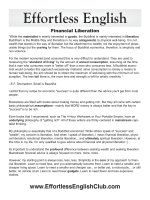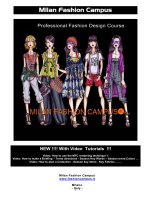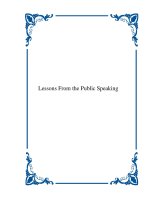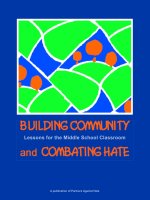Bebop l2 festival lessons
Bạn đang xem bản rút gọn của tài liệu. Xem và tải ngay bản đầy đủ của tài liệu tại đây (411.61 KB, 6 trang )
CHRISTMAS
1
2
Color the pictures. Make the bookmark. Point and say: It’s (a) (reindeer).
Key Language: Christmas, reindeer, Santa, sleigh, It’s (a) (reindeer).
This page has been downloaded from www.macmillanyounglearners.com/bebop © Macmillan Publishers Limited 2014
VALENTINE’S DAY
Paint a picture of a friend. Point and say: This is my friend.
Key Language: friend, heart, This is my friend.
This page has been downloaded from www.macmillanyounglearners.com/bebop © Macmillan Publishers Limited 2014
EASTER
Decorate the chick and egg. Make the hidden chick. Point and say: It’s (a) (chick).
Key Language: chick, egg, hen, It’s (a) (chick).
This page has been downloaded from www.macmillanyounglearners.com/bebop © Macmillan Publishers Limited 2014
CHRISTMAS
TEACHER’S NOTES
Lesson Objectives
·· learn about Christmas
·· learn Christmas vocabulary
·· understand and reply to Who and What questions
·· make a Christmas bookmark
·· strengthen fine motor skills
Key Language
·· Christmas, reindeer, Santa, sleigh, It’s (a) (reindeer).
Further Language
·· bookmark, Christmas vocabulary based on the children’s own designs
Materials
card stock paper; pictures of Christmas celebrations; large pictures or ornaments of Santa,
a sleigh, and reindeer
Preparation
Before the lesson, print one Christmas template page for each child, and glue it onto
the card stock paper. Prepare pictures relating to Christmas in the children’s country, if
appropriate for your classroom. Also display the large pictures or ornaments of Santa, a
sleigh, and the reindeer.
Lesson Notes
Show the children the pictures of Christmas in their country, if appropriate. Allow the
children time to talk about Christmas celebrations. Point to the pictures, say Christmas, and
ask the children to repeat. Then show the children the picture or ornament of Santa, say
Santa, and ask the children to repeat. Continue with the other vocabulary words.
Ask the children to color the bookmark template, and cut it out. Show the children how
to connect the two rectangles together by gluing rectangle 1 onto the flap of rectangle
2, completing the image of Santa riding in his sleigh. Help the children to fold along the
dotted line to finish the bookmark.
At the end of the lesson, check the children’s comprehension and extend learning
by scattering the pictures of reindeer, Santa, and his sleigh around the room. Ask each
child to bring a picture to you. Say Who / What is it? Encourage the children to answer
It’s Santa. / It’s (a) (reindeer).
Further Language Practice
Show the children how bookmarks are used and teach them the word. Ask them to
design their own Christmas bookmarks. Tell them the English words for the new pictures
they have drawn.
This page has been downloaded from www.macmillanyounglearners.com/bebop © Macmillan Publishers Limited 2014
VALENTINE’S DAY
TEACHER’S NOTES
Lesson Objectives
·· learn a new shape
·· learn Valentine’s Day vocabulary
·· paint a portrait of a friend
·· strengthen fine and gross motor skills
Key Language
·· friend, heart, This is my friend.
Further Language
·· brother, daddy, mommy, sister
Materials
card stock paper, paint, puppet
Preparation
Before the lesson, print one Valentine’s Day template page for each child, glue the template
onto the card stock paper, and prepare the paint. Prepare an extra template for yourself
and paint a picture of a classroom puppet inside the border.
Lesson Notes
Introduce the children to a puppet. Shake the puppet’s hand, and hug the puppet if it’s
appropriate for your classroom. Say friend. To reinforce understanding, pick two children
who you know are friends, and say friend again. Ask the children to repeat. Show them the
heart-shaped template, and say heart. Again, ask them to repeat. Have the children trace
big hearts in the air with their fingers. Then ask them to trace around the edge of the heartshaped border with their fingers.
Ask the children to paint a picture of a friend in the heart-shaped border, then cut it
out. Point to the picture you prepared before the class and say This is my friend. Have the
children repeat while pointing to their pictures.
At the end of the lesson, ask the children to move around the room with their pictures,
saying to each other This is my friend.
Further Language Practice
Have the children draw pictures of their family members. Ask them to point to each
person and say This is my (mommy).
This page has been downloaded from www.macmillanyounglearners.com/bebop © Macmillan Publishers Limited 2014
EASTER
TEACHER’S NOTES
Lesson Objectives
·· learn about the life cycle of a chick
·· learn Easter vocabulary
·· make a hidden chick
·· strengthen fine motor skills
Key Language
·· chick, egg, hen, It’s (a) (chick).
Further Language
·· animals and their babies
Materials
white card stock paper; pictures of an egg, a chick, and a hen; brass paper fasteners; small
feathers; markers; shapes cut from construction paper or other colored paper
Preparation
Before the lesson, print one Easter template page for each child, glue it onto the white card
stock paper, and cut out the egg and chick. Prepare a set of pictures of an egg, a chick, and
a hen.
Lesson Notes
Ask the children to help you to put the pictures of the egg, chick, and hen in the correct
order. Point to the first picture and say egg. Ask the children to repeat. Continue with the
other pictures.
Give each child an Easter egg and chick. Point to the chick and ask the children what’s
missing. Have the children draw in the chick’s eye. Show the children how to glue feathers
onto the chick. Then ask them to decorate the egg with the paper shapes. Show the
children how to glue the bottom of the chick to the back of the bigger section of the egg.
Help them to connect the two sections of egg together with a paper fastener, so that the
top section opens and closes to reveal / hide the chick.
At the end of the lesson, check the children’s comprehension and extend learning by
pointing to the egg or chick and asking What is it? Encourage the children to answer
It’s (a) (chick). / It’s (an) (egg).
Further Language Practice
Continue the theme of new life by giving the children other pictures of animals and their
babies to match and learn.
This page has been downloaded from www.macmillanyounglearners.com/bebop © Macmillan Publishers Limited 2014









